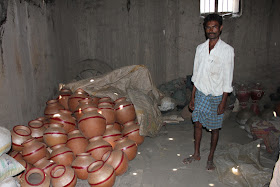I was not sure what to expect when Ningappa suggested Varavi Siddeshwara Kolavi but I felt I would see something special. Shankrappa Megappa Kumbhar the pot-maker of Hooli agreed to accompany us. The drive was a short one- Hooli > Hoolikatti > Yekkeri -less than 10km. The last one kilometer was dusty dirt track. As we neared our destination the path was just wide enough for one four-wheeler flanked by Honge trees (Derris india, Pongamila pinnata), rock hill to our left and a stream on the right. The road ended where it met the stream, we left the car under the tree and went by foot.
The stream, at this time of year barely flows but there is enough water for cattle to take a midday dip. We were entering a gully between two rock hills, packed with trees, mainly Honge trees. We were greeted by a herd of cows, buffaloes, few boys and women.

Buffaloes are pretty sensitive and were alert at the sight of strangers, especially urbanites. The honge shade relieved us from the heat radiated by the blazing Sun.

Do watch the video.
A waterfall would dominate this place between June and December and we would have very less place to walk in this valley-stream bed.

That's the temple, right next to the falls. The temple is actually a narrow gap in the rocks. Walls with a gate were made to keep monkeys away from the temple. Surely they would relieve pilgrims of their pooja stuff like coconuts and bananas.

Lord Ganesha.

This little cave temple has three Shivalingas of which two are definitely ancient and the third one looks new to me. This one is enclosed in four walls.

Aum Namah Shivaya.

Its rare to see twin Basavannas.

Outside, we look at the way we came. It's a paradise!

Walking on the rock strewn stream bed demands effort.

Shankara climbs up a rock face and I follow him up. Ningappa is worried about me, kept warning me that the rocks could be slippery. There we are; bird's eye view of the valley.

And that's where water from the hills dives down. My mind is made up to visit again sometime August or September this year.

Ascending is easy but descending is dicey. With my two cameras, it was a circus, I had to squat down couple of times.

We approached a herd of sheep. As I was trying to get a shot the herdsman offered to show his best ram and sheep.

The one holding the ram is Sangappa Bhimappa Yergatti, the boy in white is his son, the man in all white is Sangappa's brother and boy in blue shirt is Sanpappa's nephew.

When I promised to send this picture, Sangappa said "please send the picture, we'll frame it and display it at home. We'll remember you..." It'll be a crime if I did not keep up with the promise.
One last look at Onge before we leave Yekkeri.

Links to related posts-
1. Hooli fort
2. Pot makers of Hooli
May first week I posted two copies of the picture, hope the post has reached Sangappa the pot-maker.
.........
The stream, at this time of year barely flows but there is enough water for cattle to take a midday dip. We were entering a gully between two rock hills, packed with trees, mainly Honge trees. We were greeted by a herd of cows, buffaloes, few boys and women.

Buffaloes are pretty sensitive and were alert at the sight of strangers, especially urbanites. The honge shade relieved us from the heat radiated by the blazing Sun.

Do watch the video.
A waterfall would dominate this place between June and December and we would have very less place to walk in this valley-stream bed.

That's the temple, right next to the falls. The temple is actually a narrow gap in the rocks. Walls with a gate were made to keep monkeys away from the temple. Surely they would relieve pilgrims of their pooja stuff like coconuts and bananas.

Lord Ganesha.

This little cave temple has three Shivalingas of which two are definitely ancient and the third one looks new to me. This one is enclosed in four walls.

Aum Namah Shivaya.

Its rare to see twin Basavannas.

Outside, we look at the way we came. It's a paradise!

Walking on the rock strewn stream bed demands effort.

Shankara climbs up a rock face and I follow him up. Ningappa is worried about me, kept warning me that the rocks could be slippery. There we are; bird's eye view of the valley.

And that's where water from the hills dives down. My mind is made up to visit again sometime August or September this year.

Ascending is easy but descending is dicey. With my two cameras, it was a circus, I had to squat down couple of times.

We approached a herd of sheep. As I was trying to get a shot the herdsman offered to show his best ram and sheep.

The one holding the ram is Sangappa Bhimappa Yergatti, the boy in white is his son, the man in all white is Sangappa's brother and boy in blue shirt is Sanpappa's nephew.

When I promised to send this picture, Sangappa said "please send the picture, we'll frame it and display it at home. We'll remember you..." It'll be a crime if I did not keep up with the promise.
One last look at Onge before we leave Yekkeri.

Links to related posts-
1. Hooli fort
2. Pot makers of Hooli
May first week I posted two copies of the picture, hope the post has reached Sangappa the pot-maker.
.........



























































